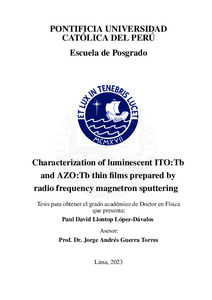Characterization of luminescent ITO:Tb and AZO:Tb thin films prepared by radio frequency magnetron sputtering
Abstract
This thesis investigates the effects of introducing terbium to indium tin oxide (ITO) and
aluminum zinc oxide (AZO) thin films on their electrical, optical and light emission properties.
The films were prepared by radio frequency magnetron co-sputtering with active
cooling during deposition. The samples maintained a high optical transmittance in the ultraviolet
and visible spectral regions. ITO:Tb showed a low electrical resistivity ranging from
5×10−3 Ω·cm to 0.3Ω·cm, whilst AZO:Tb resulted with a high resistivity which could not
be measured with the available equipment. Tb-related luminescence was obtained in ITO:Tb
after annealing at 470 ◦C in air at atmospheric conditions. Contrastingly, AZO:Tb showed
characteristic Tb luminescence in the as-grown state and further annealing treatments reduced
the Tb-related intensity. For both materials, the optical transmittance was measured at each
annealing temperature to track the changes in the optical parameters such as optical band
gap and Urbach energy. Additionally, exciton binding energy in the case of AZO:Tb was
also registered. Together with cathodoluminescence and photoluminescence (PL) measurements,
the compromise between the achieved light emission intensity, optical and electrical
properties was assessed for each material. Temperature dependence of the Tb-related luminescence
and thermal quenching was assessed by temperature-dependent PL measurements
from 83K to 533K under non-resonant indirect excitation. Thermal quenching activation
energies suggest an effective energy transfer mechanism from the host to the Tb ions. In
the case of ITO:Tb, it is assumed that a short-range charge trapping process and subsquent
formation of bound excitons to Tb ion clusters is occuring at low sample temperatures. This
indirect excitation mechanism is modeled using a spherical potential-well and a tight-binding
one-band approximation models. For AZO:Tb, a similar approach is carried out, although
the excitons are assumed to be bound to Tb ion clusters or Tb complexes that arise from the
coordination with AZO intrinsic defects.
Temas
Películas delgadas
Aluminio
Radiofrecuencia
Aluminio
Radiofrecuencia
Para optar el título de
Doctor en Física
Collections
The following license files are associated with this item:






